|
Libby's pumpkin pie is the iconic recipe that graces many American tables for Thanksgiving each year. Although pumpkin pie goes way back in American history (see my take on Lydia Maria Child's 1832 recipe), canned pumpkin does not. Libby's is perhaps most famous these days for their canned pumpkin, but they started out making canned corned beef in the 1870s (under the name Libby, McNeill, & Libby), using the spare cuts of Chicago's meatpacking district and a distinctive trapezoidal can. They quickly expanded into over a hundred different varieties of canned goods, including, in 1899, canned plum pudding. Although it's not clear exactly when they started canning pumpkin (a 1915 reference lists canned squash as part of their lineup), in 1929 they purchased the Dickinson family canning company, including their famous Dickinson squash, which Libby's still uses exclusively today. In the 1950s, Libby's started printing their famous pumpkin pie recipe on the label of their canned pumpkin. Although it is the recipe that Americans have come to know and love, it's not, in fact, the original recipe. Nor is a 1929 recipe the original. The original Libby's pumpkin pie recipe was much, much earlier. In fact, it may have even predated Libby's canned pumpkin. In 1912, in time for the holiday season, Libby's began publishing full-page ads using their pumpkin pie recipe in several national magazines, including Cosmopolitan, The Century Illustrated, and Sunset. But the key Libby's ingredient wasn't pumpkin at all - it was evaporated milk. Sweetened condensed milk had been invented in the 1850s by Gail Borden in Texas, but unsweetened evaporated milk was invented in the 1880s by John B. Meyenberg and Louis Latzer in Chicago, Illinois. Wartime had made both products incredibly popular - the Civil War popularized condensed milk, and the Spanish American War popularized evaporated milk. Libby's got into both the condensed and evaporated milk markets in 1906. Perhaps competition from other brands like Borden's Eagle, Nestle's Carnation, and PET made Libby's make the pitch for pumpkin pie. Libby's Original 1912 Pumpkin Pie Recipe:The ad features a smiling trio of White people, clearly upper-middle class, or even upper-class, seated around a table. An older gentleman and a smiling young boy dig into slices of pumpkin pie, cut at the table by a not-quite-matronly woman. A maid in uniform brings what appears to be tea service in the background. The advertisement reads: "How did you make this pie so delicious?" "Why it was easy enough. I tried the new way I found in my Libby's recipe booklet. Here it is - " "Pumpkin Pie: 1 ½ cups cooked and strained pumpkin, 2 eggs, ¾ cup sugar, ¼ cup molasses, ½ tablespoonful cinnamon, ½ tablespoonful ginger, 1/8 teaspoonful salt, 1 cup (1/2 can) Libby’s Evaporated Milk, with 1 cupful water. Mix pumpkin, molasses, sugar and spices together. Add the mixed milk and water, then add the eggs thoroughly beaten. Mix well and put into deep pie tins lined with pastry. Bake 45 minutes in a moderate oven. "Libby’s Evaporated Milk "For all pies and baking, for soups, coffee, tea or cocoa Libby’s milk gives an added richness and a delicious flavor. Libby’s milk is evaporate din clean, sanitary condenseries, located in the heart of the greatest dairy regions in the world. It is always pure and when open will keep sweet longer than raw milk. "Buy Libby’s milk for convenience and satisfaction. It’s the brand you can trust. "Send for a copy of Libby’s Milk Recipe Booklet. Libby, McNeill & Libby, Chicago." My research has not been exhaustive, but as far as I can tell, Libby's was the first to develop a recipe for pumpkin pie using evaporated milk. Sadly I have been unable to track down a copy of the 1912 edition of their Milk Recipes Booklet, but if anyone has one, please send a scan of the page featuring the pumpkin pie recipe! Curiously enough, the original 1912 recipe treats the evaporated milk like regular fluid milk, which was a common pumpkin pie ingredient at the time. Instead of just using the evaporated milk as-is, it calls for diluting it with water! The recipe also calls for molasses, and less cinnamon than the 1950s recipe, which also features cloves, which are missing from the 1912 version. Both versions, of course, call for using your own prepared pie crust. Nowadays Libby's recipe calls for using Nestle's Carnation brand evaporated milk - both companies are subsidiaries of ConAgra - and Libby's own canned pumpkin replaced the home-cooked pumpkin after it purchased the Dickinson canning company in 1929. Interestingly, this 1912 version (which presumably is also in Libby's milk recipe booklet) does not show up again in Libby's advertisements. Indeed, pumpkin pie is rarely mentioned at all again in Libby's ads until the 1930s - after it acquires Dickinson. And by the 1950s, the recipe wasn't even making the advertisements - Libby's wanted you to buy their canned pumpkin in order to access it - via the label. The 1950s recipe on the can persisted for decades. But in 2019, Libby's updated their pumpkin pie recipe again. This time, the evaporated milk and sugar have been switched out for sweetened condensed milk and less sugar. As many bakers know, the older recipe was very liquid, which made bringing it to the oven an exercise in balance and steady hands (although really the trick is to pull out the oven rack and then gently move the whole thing back into the oven). This newer recipe makes a thicker filling that is less prone to spillage. Still - many folks prefer the older recipe, especially at Thanksgiving, which is all about nostalgia for so many Americans. I'll admit the original Libby's is hard to beat if you're using canned pumpkin, but Lydia Maria Child's recipe also turned out lovely - just a little more labor intensive. I've even made pumpkin custard without a crust. Are you a fan of pumpkin pie? Do you have a favorite pumpkin pie recipe? Share in the comments, and Happy Thanksgiving! The Food Historian blog is supported by patrons on Patreon! Patrons help keep blog posts like this one free and available to the public. Join us for awesome members-only content like free digitized cookbooks from my personal collection, e-newsletter, and even snail mail from time to time! Don't like Patreon? Leave a tip!
0 Comments
Welcome to The Food Historian's 31 Days of Halloween extravaganza. Between social media (Facebook, Instagram, Twitter) and this blog, I'll be sharing vintage Halloween content nearly every day this month! Pop culture these days seems dominated by arguments over whether or not the pumpkin spice latte (or PSL) is "basic" or not, whether or not enjoying pumpkin spice flavored things can only happen during the few short months of autumn, and whether "fall creep" plays a role in "ruining" some people's summers. But have you ever wondered WHY we eat pumpkin pie spice - and other sweet spices - mostly in the fall? Pumpkin pie spice is a mixture of sweet spices - cinnamon, nutmeg, ginger, and either cloves and/or allspice. With the exception of allspice, all of these spices are native to Southeast Asia, especially the so-called "Spice Islands," more commonly known as the Maluku Islands (or Molucca Islands) near Indonesia, where nutmeg trees (which also provide mace) and clove trees originated. Cinnamon is native to Sri Lanka, and ginger is native to Maritime Southeast Asia. Allspice is also a plant of the tropics, native to the Caribbean and Central Mexico. So why do we so strongly associate these flavors with cold fall and winter months in the Northern hemisphere? A Brief History of the Spice Trade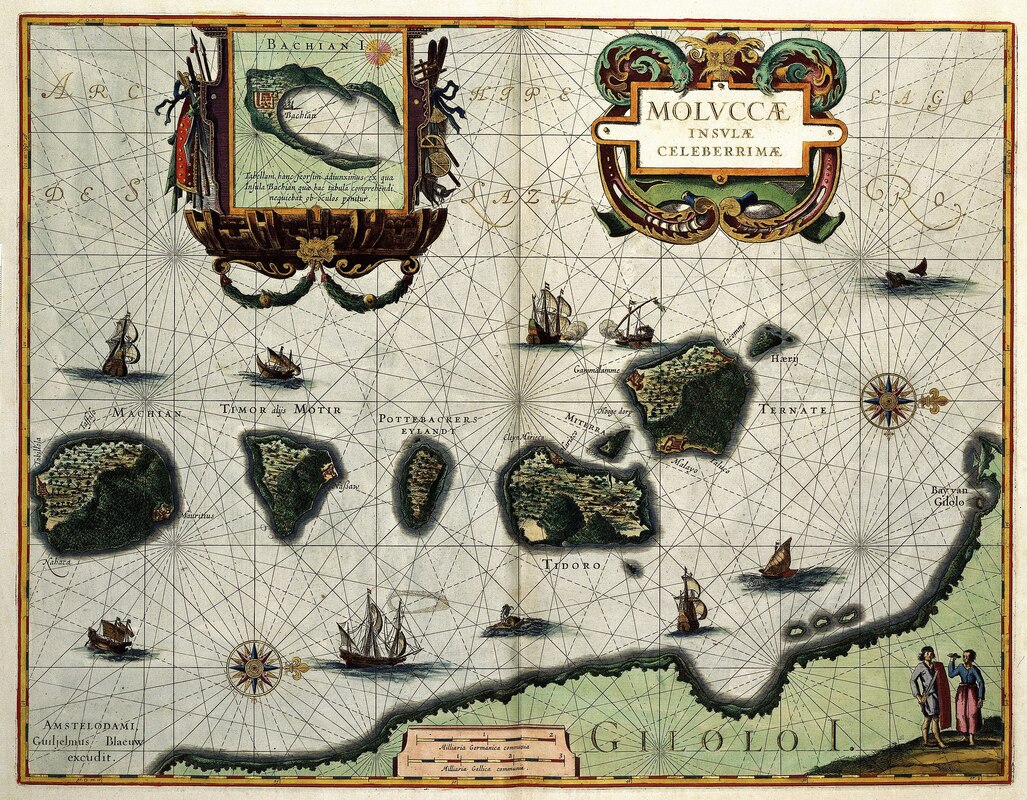 This map of the Moluccas Islands was published in 1630 by Willem Jansz. Blaeu (1571-1638). This map clearly shows that very little was known at the time about the Indonesian Archipel. The map shows the islands close together though in reality they are often thousands of miles apart. From the collections of the Koninklijke Bibliotheek. As with many things, it all has to do with money. Prior to the 16th century, all of these spices were available in Europe traveling via trade routes across Asia. Chinese and Arab traders traveled overland via the Silk Road or on ships from the Red Sea across the Indian Ocean. Cinnamon, ginger, and black pepper (native to the Malabar coast of India) were all known in Europe as far back as Ancient Rome. For centuries, Venice controlled much of the flow of spices into Europe, and the wealth gained by the spice trade may have helped spark the Renaissance. But when the Ottoman Empire wrested control of the spice trade from Europeans in 1453, things changed. European nations, spurred by improvements in naval technology, started to search for their own routes to control the lucrative spice trade. Indeed, most of the European "explorers" who ended up in the Americas were searching for a shortcut to Asia and a way to bypass the control of the Muslim Ottoman Empire and cut out the middleman altogether, ensuring massive profits. Instead of dealing with existing trade relationships, as Asian and Arab traders had for centuries, Europeans simply took what they wanted by force. The Dutch were particularly violent as they tried to take control of the Spice Islands through genocide and enslavement. Even after the plants that produced these valuable spices were successfully propagated outside their native habitats, the plantations which grew them commercially were often owned by foreign Europeans and also used enslaved labor to produce the spices more cheaply than ever. Like sugar and chocolate, the plantation economy allowed spices to be produced in massive quantities quite cheaply. The flavors that were once the purview only of wealth European aristocrats were, by the end of the 18th century, much more widely affordable by ordinary people. By the middle of the 19th century, ginger, cinnamon, nutmeg, mace, and cloves (along with sugar and cocoa) were positively common. Which is why foods like gingerbread cake, spice cake, and spiced pumpkin and apple pies became such indelible parts of American food history. But why the association with fall? In European cuisine, the most expensive foods were served around special feast days, like Christmas and Twelfth Night. Fruit cakes were rich in spices, spices flavored custards and puddings, and cookies flavored with ginger, cinnamon, mace, nutmeg, and cloves were all staples of the winter holidays. As spices became less expensive over time, they were used in other applications, but their association with the holidays - and cold weather - continued. In the United States, Americans flavored the prolific native squash with the now-familiar mixture of spices in a smooth custard pie. Pumpkin pie was born. Creating "Pumpkin Pie Spice"The name "pumpkin pie spice" refers to the mix of spices used to flavor pumpkin pies - among other things. Sadly, the mix itself contains no actual pumpkin, which is quite confusing when it is used as a flavoring agent sans pumpkin. Developed to flavor the smooth squash custards in a flaky crust we've all come to associate with Thanksgiving, the mixture of sweet, exotic spices was extremely popular. But as the 19th century turned to the 20th, the idea of hand grinding whole spices in a mortar and pestle was not only time-consuming, it threatened the use of spices altogether. Spice and extract companies like McCormick had been around since the late 19th century, but the 20th century brought a whole host of other companies to the scene, especially post WWII. The spice mix itself was commercialized first during the early 20th century, as spice and flavorings companies brainstormed ways to make baking easier and more economical for customers. Thompson & Taylor spice company was the first to create "ready-mixed pumpkin pie spice." The above advertisement, first published in 1933, features a woman asking an older woman with glasses "Mother - Why is it your pumpkin pies are never failures?" The older woman, who is spooning something into a pie crust, answers, "T&T Pumpkin Pie Spice my dear, makes them perfect every time." The advertisement goes on to read, "Home-made pumpkin pie, perfect in flavor, color and aroma, demands the use of nine different spices. The spices must be exactly proportioned, perfectly blended, and, above all, absolutely fresh. For reasons of economy, most housewives are right in hesitating to buy nine spices just for pumpkin pie. But here is news! Now, for the fist time, you can get the necessary nine spices, ready-mixed for instant use, in one 10c package of T&T Pumpkin Pie Spice - enough for 12 pies." Of course, they don't want to tell you what those nine spices are! But likely it was a mixture of cinnamon, ginger, nutmeg, allspice, and cloves, and perhaps also mace, cardamom, star anise, and black pepper. Two years later, McCormick advertised their own "Pumpkin Pie & Ginger Bread Spice," a blend of "ginger, cinnamon, nutmeg, cloves and other spices." I love that it is advertised as good for both pumpkin pie and gingerbread. Although we often associate gingerbread with Christmas, it was also often served at Halloween and throughout the colder months. As canned pumpkin grew in popularity in the 20th century, other pumpkin desserts were also developed to use the same spice profile, including pumpkin spice cake. Here's the recipe as written in the St. Louis Dispatch. Feel free to substitute shortening (and the margarine!) for butter. Pumpkin Spice Cake 1/2 cup shortening 1 cup sugar 2 eggs 1 cup canned pumpkin 3 teaspoons baking powder 2 cups flour 1 teaspoon cloves 1/2 teaspoon nutmeg 2 teaspoons cinnamon 1/4 teaspoon salt 1/2 cup chopped dates 1/2 cup rich milk METHOD: Cream shortening and sugar, add eggs, one at a time, and beat well, then stir in pumpkin. Sift dry ingredients and add alternately with milk. (If pumpkin is very dry, add more milk.) Stir in dates and bake in a loaf, in a moderate oven, 350 degrees Fahrenheit. To serve, slice thinly and spread with margarine. Delicious for tea. Spiced pumpkin foods were largely relegated to desserts for most of the 20th century - pumpkin bars, cakes, muffins, and cookies were all popular, especially after the Second World War. But we weren't at peak pumpkin spice saturation just yet. Enter, the Pumpkin Spice Latte. The Pumpkin Spice Latte and BeyondFounded in 1971 near Pike Place Market in Seattle, Washington, Starbucks originally started as a whole bean coffee company. But the specialty coffee business caught on in the dot com boom of the 1990s and franchises spread all over the country. In the 1980s, Starbucks had developed the popular holiday eggnog latte. The addition of a peppermint mocha in the early 2000s piqued corporate interest in specialty holiday drinks available for a limited time. They trialed a variety of drinks with focus groups, and the pumpkin spice latte was the surprise favorite. Released in 2003, it became a national phenomenon that only grew with time. Starbucks was not the first to develop a pumpkin spice flavored latte, but they certainly popularized it. Nowadays September and October bring the onset of just about everything pumpkin spice flavored, regardless of the weather conditions where you live. And that's the weird thing about pumpkin spice - today it is totally divorced from its geography and history. Born in the tropics, the product of genocide, enslavement, and greed, and associated for centuries with wealth and holidays, today it represents shorthand for a near-fictional concept of autumn that most Americans don't experience. Even in stereotypical New England, where pumpkin pie spice was arguably born, climate change is making autumn shorter and warmer. I'm all for letting people love what they love, and PSL and pumpkin spice are no different. I love a good spiced pumpkin dessert, don't get me wrong. But for all the fuss about pumpkin spice, I'm an apple cider girl myself. Just don't tell Starbucks or the people who seem to think everything from breakfast cereals to hand soap should be flavored with pumpkin spice. What do you think? Are you a fan of pumpkin spice? Tell me how you really feel in the comments! And if you want to learn more about the history of pumpkin pie, check out my talk "As American As Pumpkin Pie: From Colonial New England to PSL" - available on YouTube. The Food Historian blog is supported by patrons on Patreon! Patrons help keep blog posts like this one free and available to the public. Join us for awesome members-only content like free digitized cookbooks from my personal collection, e-newsletter, and even snail mail from time to time! Don't like Patreon? Leave a tip! Last week I did the first of a series of several talks with cooking demonstrations for the Poughkeepsie Library. The first was all about pumpkin pie and I made Lydia Maria Child's original pumpkin pie recipe from her 1832 cookbook The American Frugal Housewife, and then followed it with a discussion of the history of pumpkin, pumpkin pie, and pumpkin pie spice. The library recorded the talk, so you can check it out below! Lydia Maria ChildLydia Maria Child was born in Medford, Massachusetts in 1802. When she moved to Maine as a young woman to study to be a teacher, her older brother Convers, who had attended Harvard Seminary, assisted with her literary education. Upon reading and article about the rich resources New England history could provide novelists, she launched an unplanned writing career with her first novel, Hobomok, published in 1824. The book was set in 17th century New England and concerned the lives of a Native man, Hobomok, and the White woman he married and had a child with. Initially rejected by critics for its theme of miscegenation, it was later lauded by Boston literary circles. While teaching, Lydia Maria turned her attention to writing again, founding Juvenile Miscellany in 1826 - the first American monthly periodical designed specifically for children. Under Child's editorship, it became a popular and groundbreaking publication, emphasizing Protestant morality without the boring proselytizing common in children's literature at the time. In 1828 she married David Lee Child, a Boston lawyer and journalist (her maiden name was Francis) and stopped teaching, but not writing. In 1829 she published The Frugal Housewife: Dedicated to those who are not ashamed of economy, a cookbook directed at assisting the lower classes. It was published in several editions until 1832, when she changed the name to The American Frugal Housewife, to differentiate it from another cookbook of the same title published in Britain. Child published several other books on motherhood and household management, but her abolition work and radical politics largely derailed her literary career. She and her husband David Child began to identify as abolitionists in 1831. In 1833, she published An Appeal in Favor of that Class of Americans Called Africans, which called, among other things, for total abolition of slavery without compensation to enslavers. It was the first anti-slavery book (not pamphlet) published in the United States. Throughout the 1830s and '40s she became very active in the abolition and anti-slavery movements, publishing anti-slavery fiction, anti-slavery political tracts, and organizing fundraisers and events. Her anti-slavery stance and other radical politics enraged many readers in the American South, and subscriptions to Juvenile Miscellany declined so much that in 1834 she stepped down as editor. Sarah Josepha Hale edited the magazine until its closure in 1836. Child went on to publish tracts supporting Native American rights as well, including An Appeal for the Indians in 1868. Lydia Maria Child died in 1880 at the age of 78. Because of her political beliefs, she did not see the financial success of many of her author peers. But The American Frugal Housewife remains one of her most enduring legacies, along with her most famous poem, "A New England Boy's Song About Thanksgiving Day," which she published as part of her book Flowers for Children, Vol. 2 in 1844. You might know it better as "Over the River and Through the Woods." "A New England Boy's Song About Thanksgiving"Over the river, and through the wood, To grandfather's house we go; The horse knows the way, To carry the sleigh, Through the white and drifted snow. Over the river, and through the wood, To grandfather's house away! We would not stop For doll or top, For 't is Thanksgiving day. Over the river, and through the wood, Oh, how the wind does blow! It stings the toes, And bites the nose, As over the ground we go. Over the river, and through the wood, With a clear blue winter sky, The dogs do bark, And children hark, As we go jingling by. Over the river, and through the wood, To have a first-rate play -- Hear the bells ring Ting a ling ding, Hurra for Thanksgiving day! Over the river, and through the wood -- No matter for winds that blow; Or if we get The sleigh upset, Into a bank of snow. Over the river, and through the wood, To see little John and Ann; We will kiss them all, And play snow-ball, And stay as long as we can. Over the river, and through the wood, Trot fast, my dapple grey! Spring over the ground, Like a hunting hound, For 't is Thanksgiving day! Over the river, and through the wood, And straight through the barn-yard gate; We seem to go Extremely slow, It is so hard to wait. Over the river, and through the wood, Old Jowler hears our bells; He shakes his pow, With a loud bow wow, And thus the news he tells. Over the river, and through the wood -- When grandmother sees us come, She will say, Oh dear, The children are here, Bring a pie for every one. Over the river, and through the wood -- Now grandmother's cap I spy! Hurra for the fun! Is the pudding done? Hurra for the pumpkin pie! "Pumpkin And Squash Pie" (the filling)Here is Lydia Maria Child's original text: "For common family pumpkin pies, three eggs do very well to a quart of milk. Stew your pumpkin, and strain it through a sieve, or colander. Take out the seeds, and pare the pumpkin, or squash, before you stew it; but do not scrape the inside; the part nearest the seed is the sweetest part of the squash. Stir in the stewed pumpkin, till it is as thick as you can stir it round rapidly and easily. If you want to make your pie richer, make it thinner, and add another egg. One egg to a quart of milk makes very decent pies. Sweeten it to your taste, with molasses or sugar; some pumpkins require more sweetening than others. Two tea-spoonfuls of salt; two great spoonfuls of sifted cinnamon; one great spoonful of ginger. Ginger will answer very well alone for spice, if you use enough of it. The outside of a lemon grated is nice. The more eggs, the better the pie; some put an egg to a gill of milk. They should bake from forty to fifty minutes, and even ten minutes longer, if very deep." And here's my translation: 1 sugar pie pumpkin 2 cups whole milk 4 eggs 2 tablespoons cinnamon 1 tablespoon ground ginger 1/2 teaspoon salt 1/4-1/2 cup maple syrup Cut pumpkin in half, scoop out seeds, and roast, cut-side down, for 45 minutes at 350 F. When soft and easily pierced with a knife, remove from oven and scoop out flesh from rind. Mash thoroughly with a fork to remove stringiness. Let cool, then add spices and salt and mix thoroughly, then add all liquid ingredients. Pour into chilled pie shells (recipe below) and bake at 450 F for 15 minutes, then reduce heat to 350 F and bake for an additional 30 minutes. When the center is solid (a slight wobble is allowed), the pie is set and baked. Serve warm or cold with additional maple syrup (if desired) and whipped cream (recipe below). If you have extra filling, add to ungreased glass baking dishes or custard cups for equally good "crustless pumpkin pie." "Pie Crust"The original: "To make pie crust for common use, a quarter of a pound of butter is enough for half a pound of flour. Take out about a quarter part of the flour you intend to use, and lay it aside. Into the remainder of the flour rub butter thoroughly with your hands, until it is so short that a handful of it, clasped tight, will remain in a ball, without any tendency to fall to pieces. Then wet it with cold water, roll it out on a board, rob over the surface with flour, stick little lumps of butter all over it, sprinkle some flour over the butter, and roll the dough all up; flour the paste, and flour the rolling-pin; roll it lightly and quickly; flour it again; stick in bits of butter; do it up; flour the rolling-pin, and roll it quickly and lightly; and so on, till you have used up your butter. Always roll from you. Pie crust should be made as cold as possible, and set it in a cool place; but be careful that it does not freeze. Do not use more flour than you can help in sprinkling and rolling. The paste should not be rolled out more than three times; if rolled too much, it will not be flaky." Well that was a bit of a doozy of a recipe! Essentially, she's making an all-butter pie crust by combining shortbread and puff pastry techniques. And it turns out pretty well! If you're looking for a good all-butter pie crust recipe, this is a fairly reliable one, if you handle it gently. Here's my translation: 1 stick (1/4 pound) very cold unsalted butter 1 1/4 cup all-purpose flour 1/4-1/2 cup reserved flour for rolling ice water With cold hands, cut the stick of butter lengthwise in thirds, then rotate one quart of the way and cut in thirds again. Then cut crosswise until you have nice little cubes. Use at least half of the butter to rub into the 1 1/4 cup flour in a large bowl. Add more butter if you need to. From a bowl of ice water, using a tablespoon, add the water, 1-2 tablespoons at a time, and toss mixture with a fork. You'll need 6-8 tablespoons, depending on your flour and butter ratios. When you can make a ball with your hands and it sticks together nicely, but not too wet, you're good. Form the mass into a ball and roll out on a well floured surface, taking care to roll gently so as not to break the dough or roll unevenly. Once you have rolled out a round, spread whole cubes of butter across half the circle, fold in half, and roll that flat. Then repeat 2 more times (making sure to reserve enough butter for each rolling). When complete, roll out for crust. You'll have at least one single crust, with some left over for smaller pies. Place in pans, trim and crimp edges, and chill until ready to fill. Bake with pumpkin filling as directed above, or add your favorite fruit filling. My crust turned out delightfully crisp, but a little flat in flavor. A pinch of sugar and/or salt would probably be a nice addition. Hand Whipped CreamThis one isn't in The American Frugal Housewife, but it goes deliciously with pumpkin pie! The higher quality/fat content your cream, the easier it is to whip by hand. 1/2 cup heavy cream 1 tablespoon sugar or maple syrup 1 teaspoon homemade vanilla (recipe below) In a very deep bowl (preferably glass, which stays nice and cold), add the chilled cream, sugar, and vanilla. Tilt bowl and beat cream with a wire balloon whisk in a circular motion until you add enough air to the cream that it holds its shape. Do not overbeat, or you'll end up with sweet vanilla butter. Chill until ready to serve. Homemade VanillaHomemade vanilla lasts nearly forever, so it's a worthy investment, but vanilla beans are quite expensive these days, so make at your own expense. Still probably cheaper than buying the tiny bottles of the real stuff. You can make it with vodka, but I find the gold rum is much nicer and mellower. Also makes a great Christmas present. A dozen or so whole vanilla beans Gold rum (get the not-quite-the-cheapest brand) Cut the vanilla beans in half and add them to a quart jar. Fill jar with gold rum. Let sit in a dark place for a week or so before using. Keep adding rum as you deplete the vanilla. You want to keep the beans submerged at all times. Add beans every few years to keep the flavor up. Happy Thanksgiving!And that, my dears, is that. If you made it this far through the blog post, congratulations! I hope you enjoyed the video, some history about Lydia Maria Child, her famous poem, and the recipes. Keep your eyes peeled for more cooking-demonstration-and-talk programs coming up in December, January, and February. I hope you have a wonderful Thanksgiving! As always, The Food Historian blog is supported by patrons on Patreon! Join us for awesome members-only content like free digitized cookbooks from my personal collection, e-newsletter, and even snail mail from time to time! |
AuthorSarah Wassberg Johnson has an MA in Public History from the University at Albany and studies early 20th century food history. Archives
July 2024
Categories
All
|

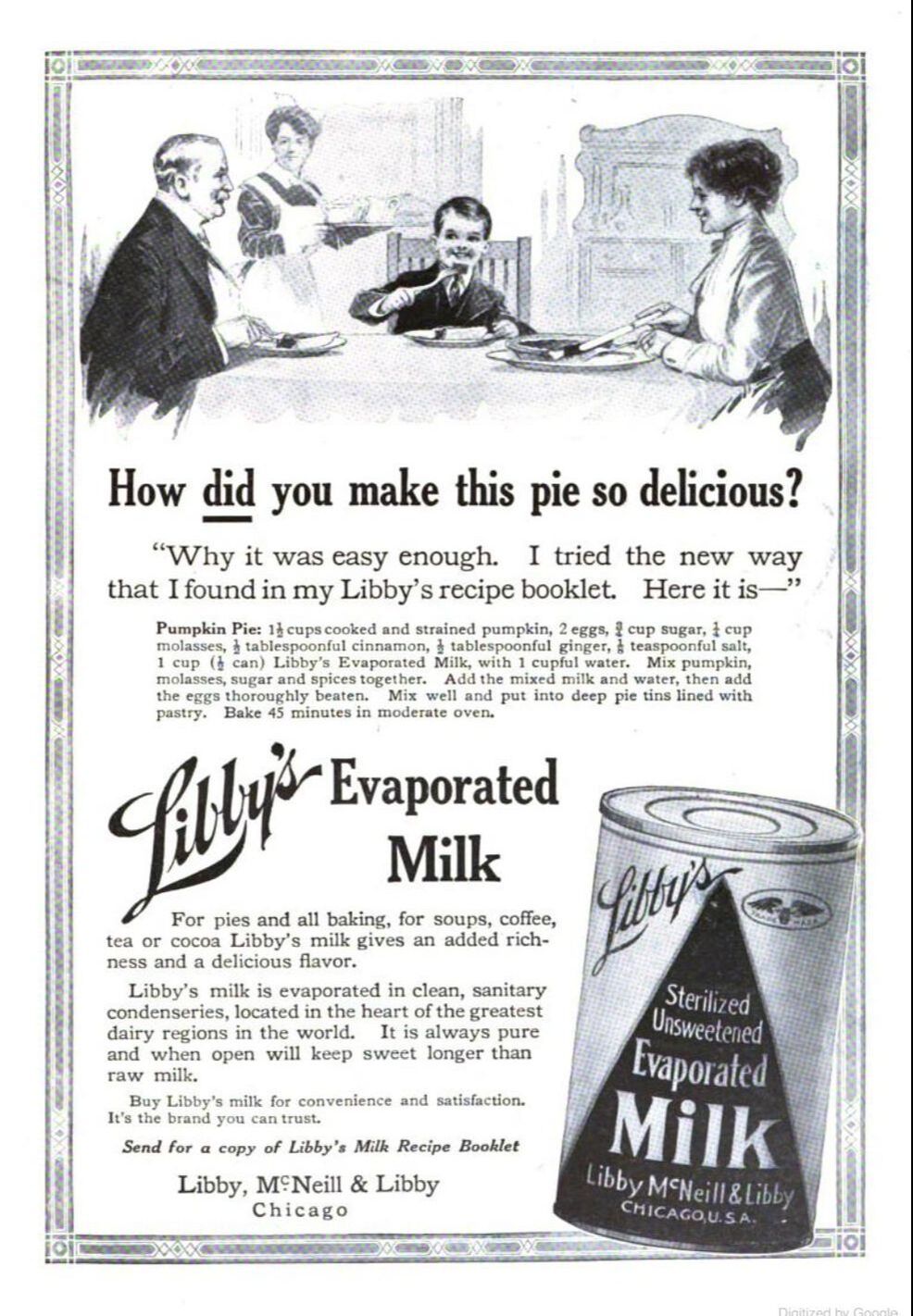
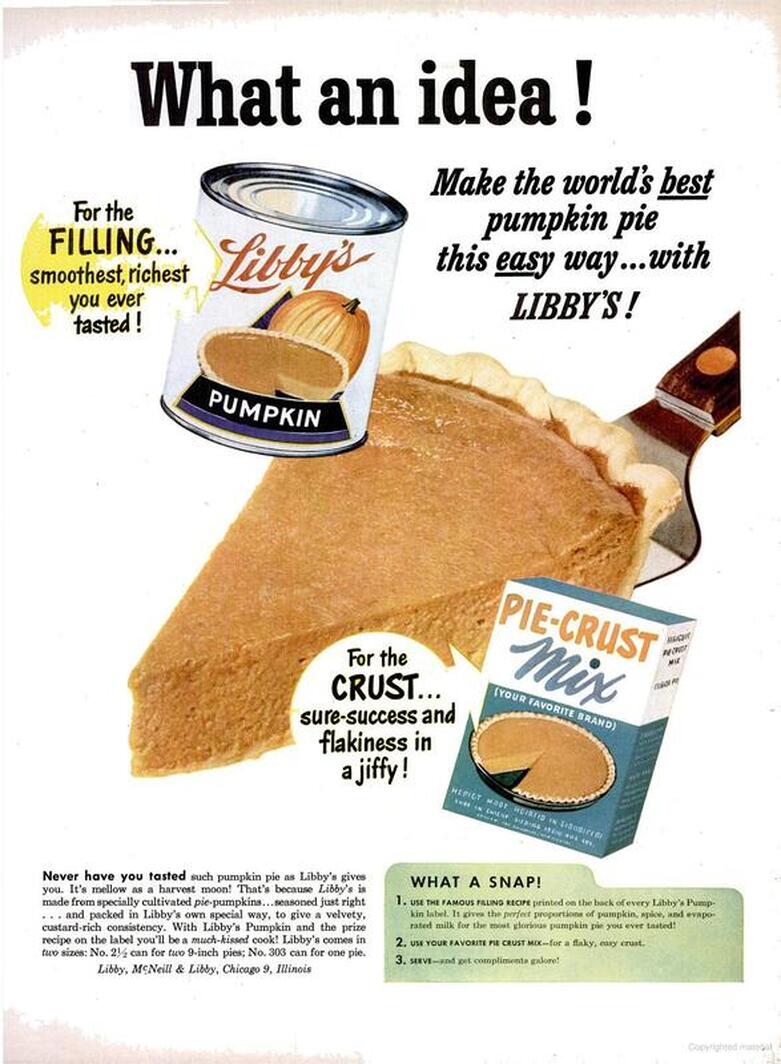
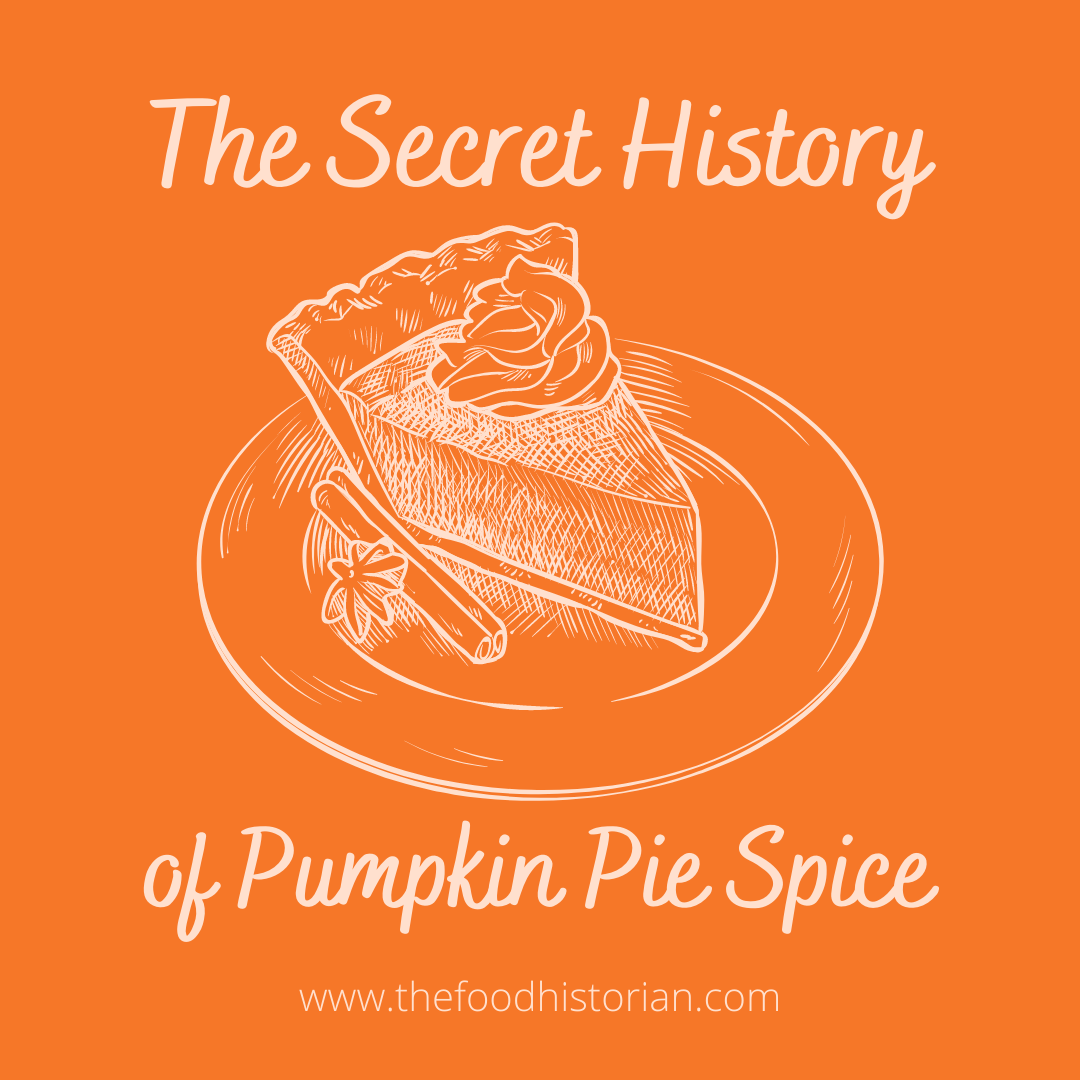
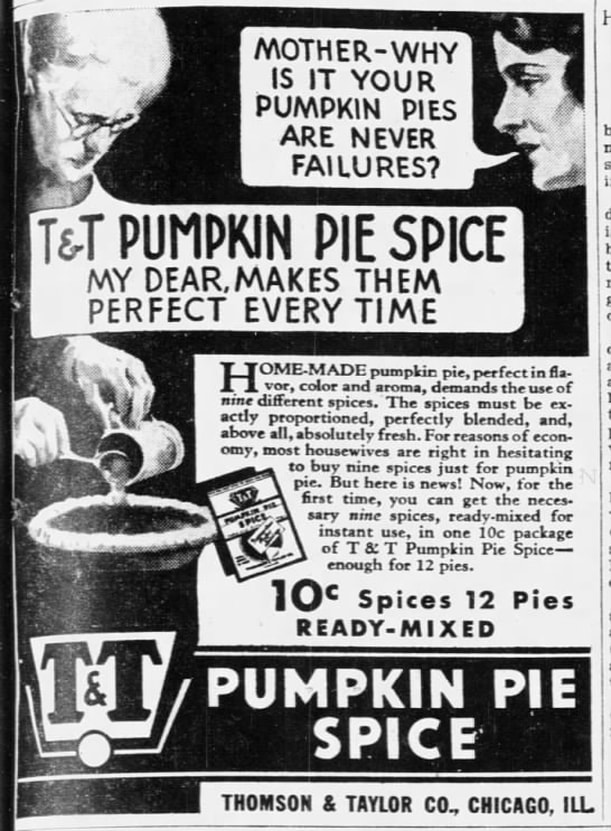
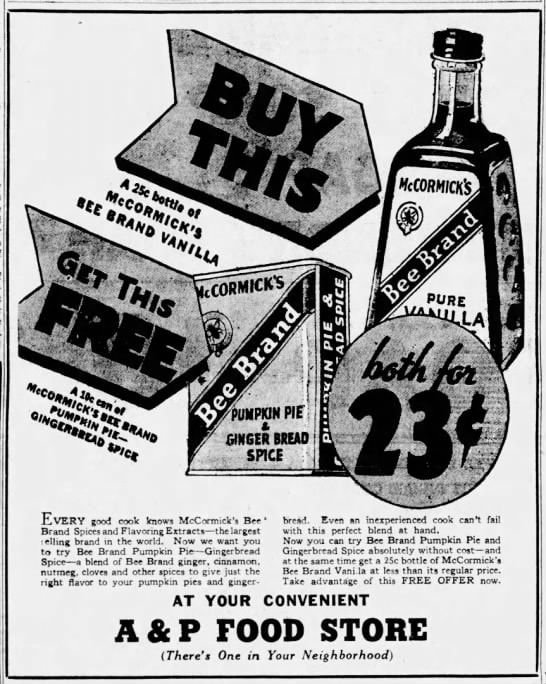

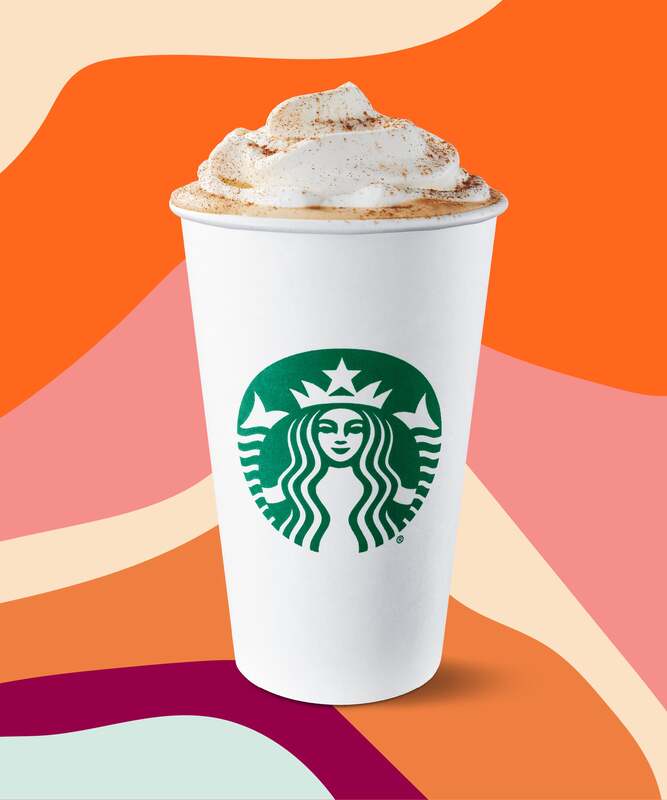



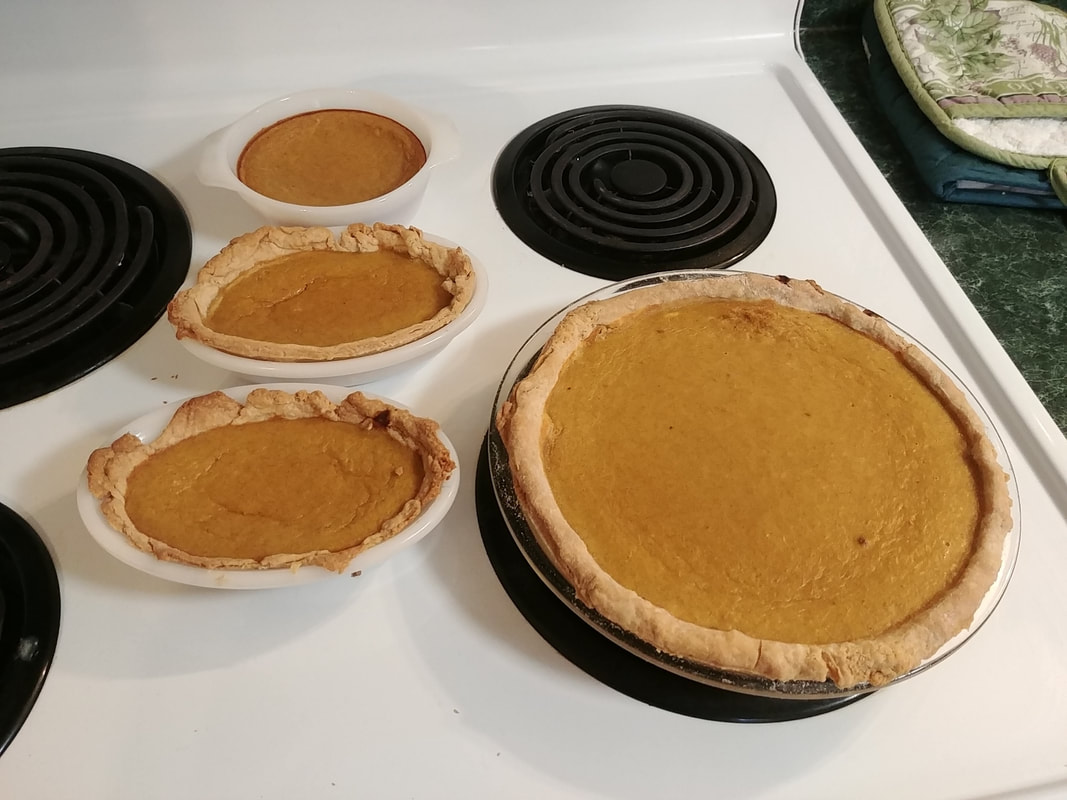




 RSS Feed
RSS Feed